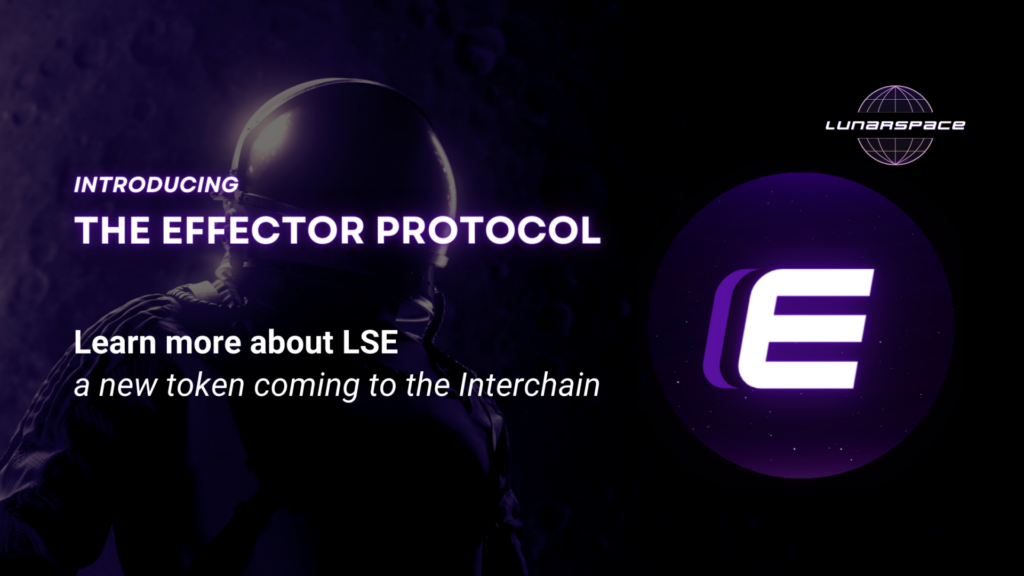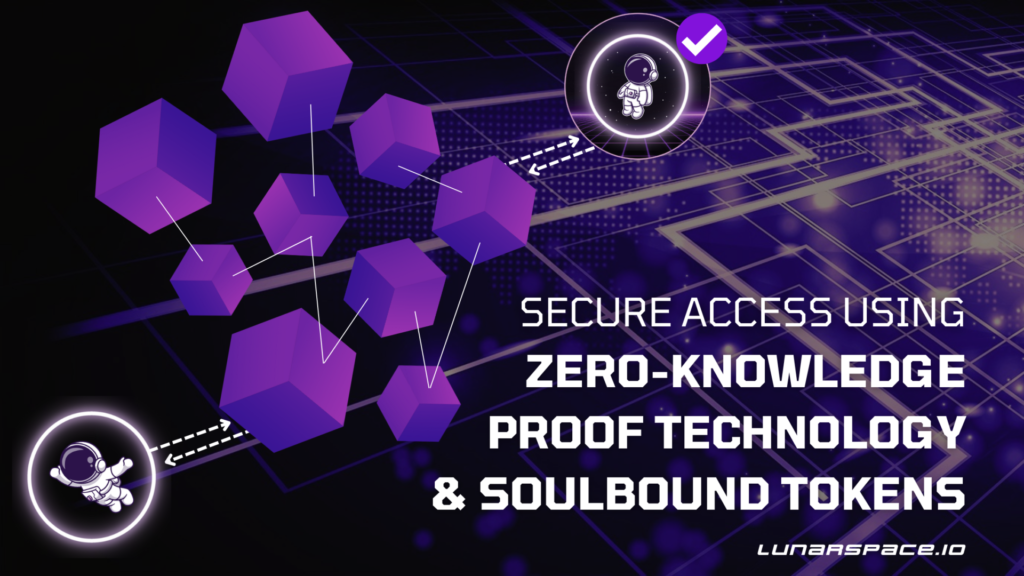The Effector Protocol (LSE) Explained
Introducing the Effector Protocol, Lunarspace’s latest innovation for the Zones ecosystem.
by TendermintTimmy & Decentranaut
Powered by its native utility token LSE, the Effector Protocol is set to introduce a paradigm shift in the way utility tokens are built and applied. At its core, the Effector Protocol is engineered to infuse enhanced functionality, governance, and operational dynamics into Zones’ existing token economy. It’s a step toward a more interconnected and efficient blockchain environment where LSE becomes the driving force behind new liquidity opportunities and asset growth within and outside of the Zones ecosystem.

What is the Effector Protocol?
“The Effector Protocol” is a term for the suite of utilities built around the LSE token, making the LSE token the first example of what we like to call, an Effector token.
While this isn’t necessarily a new token standard, it is a new way to think about how secondary (or tertiary) tokens can influence and play into web3 systems.
An “Effector” token, such as LSE, is not designed to be the core component of a given protocol, rather it’s a component designed to augment and effect a given protocol in a variety of different ways that the user must pick between. This means, for any utilities or functions that an effector token has, only one effector token can be utilized at a time for any given task.
This not only allows both new and existing systems to become less rigid through the addition of tweaks that secondary tokens can cause, but also serves as a strong base for building tokenomics that reinforce each other. So let’s get to some examples!
While this list will grow over time, at launch, LSE’s utilities will include governance participation, revenue sharing, optimizing efficiency of the LSX:HAMP dynamic in Zones, priority order processing in LSX mints & redemptions, and market making and arbitrage opportunities.
Hybrid Governance
As a hybrid web2-web3 entity, Lunarspace aims to strike a balance when it comes to protocol level decisions and alterations after launch. Put simply, we want to tap into the power that web3 governance provides, but in a unique way that works with our partially centralized, business-centric nature.
Holders will be able to bond LSE into a governance DAO that gets final say on all changes to most aspects of on-chain code as it pertains to Zones.
The Lunarspace team will not maintain any voting stake in this DAO themselves, however only the Lunarspace team is able to put new proposals up for vote. This means that ultimately, no change can come to any on-chain parameters without both the community majority, and the Lunarspace team being in agreement; the ultimate goal of any governance system.
In addition, 2% of all net revenue generated by Lunarspace the company and Lunarspace the on-chain protocol, will be distributed to Governance participants once a month.
Revenue Sharing and Stakeholder Alignment
Revenue sharing is a cornerstone of the protocol, providing a tangible reward for those who lock in their LSE tokens. This aligns the success of the individual with the prosperity of the platform, ensuring that when the ecosystem thrives, so do its participants. This utility is as straightforward as it comes.
Lunarspace is committed to distributing 10% of its net revenue, from both on-chain and off, back into its community. Along with the 2% that goes to governance voters, the other 8% is distributed to this contract once at the end of every month.
The setup for this contract is something unique to the concept of an Effector token, in that that is all that this contract does. You lock up your LSE, you get a share of 8% of net revenue, proportional to how much LSE you have bonded relative to others.
There will be some time periods where this may be the obvious, most profitable choice for how to use your LSE, however, that will naturally change as people pile in for that very reason, and your share of that 8% dwindles until one of the other utilities starts to make more sense. This general principle should be true for all utilities that an Effector token can be used for, and that is indeed the case for LSE.
Boosting Zone Efficiency
The integration of LSE into Zones not only elevates Zone efficiency but also Zone output. By bonding LSE tokens to one of two contracts, users can either increase the amount of HAMP they generate, or raise the cap on the amount of LSX they’re able to claim from HAMP in a given month.
For brief context, as team members/employees perform tasks within a Zone, they generate HAMP. HAMP can be redeemed for LSX, up to a monthly cap imposed by the amount of LSX in that Zone’s vault.
In this way, LSE can be used as a more flexible alternative to altering the size of your vault’s LSX stake, and the overall metrics and parameters for your Zone’s LSX/HAMP dynamic. We’ll most likely go into this in more detail in a separate piece, as there’s a lot to unpack under the surface here.
Priority Redemptions & Mints for LSX
A core part of the Zone’s platform is the ability for users and clients to buy/mint LSX directly from Lunarspace for $1 each, as well as redeem them for $0.99 each. Lunarspace plans to then keep these funds in a yield-bearing vault to act as “backing” for LSX.
New LSX can only be brought into existence in one of two ways, either through an active Zone converting their HAMP, or through this system.
Without going into too much detail here, there are limits on how much LSX can be minted or redeemed through this contract, however users are able to place orders that will auto-fill when the system is not at its limit. The more LSE a user holds, or is using in any of the other Effector Contracts, the higher their order’s priority is in the queue when the system goes to fill orders.
This makes it so that in addition to the “standard” arbitrage opportunities that LSX & LSE provide, there is a bonus incentive for people participating to hold more and more LSE, as it will help them front-run others and be more effective dollar-per-dollar with their arbitrage.
Elevating Market Dynamics
LSE isn’t just about participation and rewards. It introduces a new layer to the market dynamics within the Zones token economy. Market making, arbitrage opportunities, and prioritized transactions in LSX-related activities are all enhanced through the utility of LSE tokens.
The LSE/LSX pool will be both seeded and incentivized by Lunarspace, ensuring it remains deep and liquid. This, combined with the ability for LSX to be minted or redeemed directly with Lunarspace, for $1 or $0.99 respectively, but only up to a certain amount per month, makes LSX the perfect pseudo-stablecoin to arbitrage.
And with LSE both having the deepest liquidity pairing with LSX, as well as being needed for priority in those direct mints and redemptions, it naturally falls into place as a key – and highly profitable – part of the entire system.
LSE Tokenomics: A Balanced Ecosystem
The LSE token stands at the center of the Effector Protocol, meticulously designed to sustain and grow the Lunarspace ecosystem. The tokenomics are tailored to foster an equitable and thriving environment where every stakeholder sees the value.
Max Supply: 100m LSE tokens – A cap that guarantees scarcity and value, underpinning the token’s economic stability.
Circulating Supply: 100m LSE tokens – Reflecting a transparent and immediate distribution strategy that aligns with the ecosystem’s growth trajectory.
Initial Target Price: ~$0.01 – An entry point that ensures accessibility for early adopters and a broad investor base.
Initial Target Market Cap: ~$1m – A foundation that balances market presence with ample room for appreciation.
Genesis Allocation: 60m tokens allocated to Outbid, 40m tokens in circulation.
This strategic token allocation not only ensures a robust entry into the market but also underpins the sustained growth and utility of the LSE token within the ecosystem.
Outbid Launch: Setting the Stage for LSE
The Outbid campaign marks the beginning of LSE’s journey. It’s a unique opportunity for the public to participate in establishing the token’s initial value. The genesis allocation to Outbid of 60,000,000 LSE is meticulously planned to ensure a balanced distribution that serves various aspects of the ecosystem:
Outbid Allocation: 60% – A fair and open event that lays the foundation of LSE’s market value.
Liquidity Pools: 15% – Ensures a smooth trading experience post-launch, with pools set up with LSX and potentially stable assets like USDC.
Future Airdrops: 10% – Scheduled for strategic distribution to support ongoing engagement and ecosystem growth.
Pool Incentives: 5% – Crafted to promote liquidity provision and active participation within the ecosystem.
Archway Developer Incentives: 5% – Aligned with fostering innovation and development on the Archway platform.
Team Allocation: 5% – Reserved for future grants and onboarding web2 clients seamlessly into the blockchain domain.
LSE token genesis through the Outbid campaign is more than just a launch—it’s a commitment to a blockchain utility that propels the community forward. As we pave the way for LSE’s integration into the Interchain, we pioneer a new era of decentralized utility, governance, and market dynamics.
Building dZones on Archway
Archway serves as the backbone for dZones, (formerly referred to as Utility Zones) providing developers with the tools and resources needed to innovate and thrive. Building on Archway is a deliberate choice, harnessing the power of its smart contract capabilities to deliver unrivaled efficiency and developer-friendly features.
Why Archway?
Developer First: Archway’s incentives for developers put them at the forefront, rewarding contributions and encouraging a vibrant development landscape.
Seamless Integration: With dZones, Archway facilitates the blending of traditional and blockchain-based tools, paving the way for web2 developers to transition into web3 with ease.
Robust Infrastructure: Archway’s robust infrastructure ensures that dZones are built on a platform that is secure, scalable, and forward-looking.
The dZones Advantage
The next article will dive deep into the world of dZones exploring how they leverage the strengths of Archway to offer an array of applications and services. From the DevZone to customized community platforms, dZones represent the next frontier in blockchain utility—stay tuned.
As we approach the launch of dZones, anticipation builds for what these innovations will mean for the ecosystem. With Archway as the cornerstone and LSE as the catalyst, we’re not just anticipating a new product—we’re setting the stage for a new chapter in blockchain utility.
Embracing LSE's Potential
As we inch closer to the genesis of the Effector Protocol, the Outbid launch stands on the horizon, not just as a milestone for Lunarspace and the blockchain community, but as a gateway to a more interconnected and vibrant Zones ecosystem. It’s an invitation to be at the forefront of a new era where governance, efficiency, and innovation converge through the Effector Protocol and the Zones ecosystem.
Keep your eyes peeled for our upcoming content, which will delve deeper into the practical applications of LSE within Utility Zones and beyond. This series will continue to unfold the story of the Effector Protocol and the Zones ecosystem, providing you with insights, guidance, and the latest developments from Lunarspace.
Don’t miss out! Follow @LunarspaceIBC, @decentranaut, @LSgroundcontrol, and @TendermintTimmy on x.com for continuous updates.
Want to stake your claim to the Zones ecosystem before launch? Join the whitelist, purchase LSX, and join our community!
For more insights into how Zones can transform your business and to join our journey towards innovative solutions, sign up for the Zones Whitelist. Stay updated with the latest developments and dive deeper into blockchain-integrated business solutions with more blogs from Lunarspace.
Ready to revolutionize your business operations? Join the whitelist or contact Lunarspace today and become part of the pioneering journey into the future of enterprise solutions.







